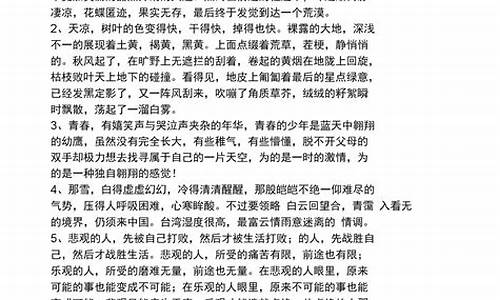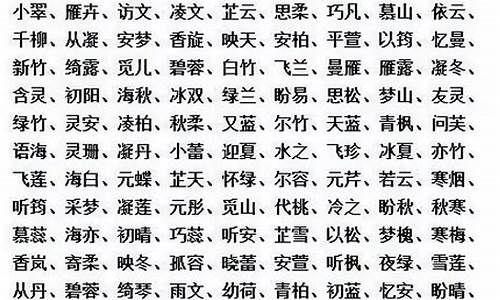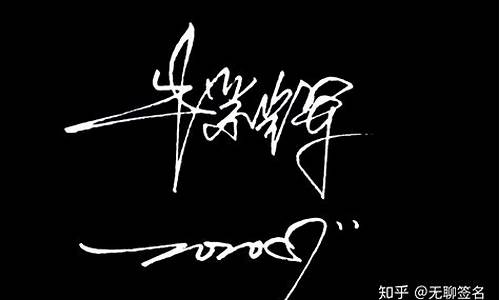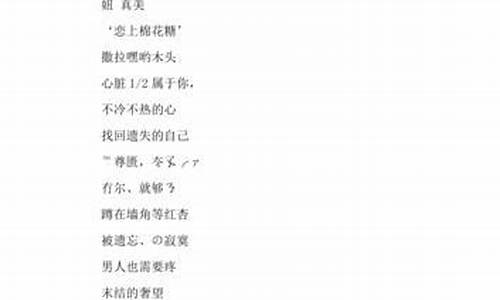您现在的位置是: 首页 > 经典语录 经典语录
句子的类型都有什么_句子类型有哪些种类
tamoadmin 2024-08-23 人已围观
简介1.英语句子的种类有哪些?有例句吗?2.英语句子类型的并列句和复合句有什么不同3.句子都有哪些种类 中国的句子4.英语中句子类型有哪四种5.英语句子的种类和用法,有哪些啊?6.英语句子分几种类型?7.句子的类型有哪些?快!一般有简单句,复合句,复合句。复合句:即简单句的某个成分变成了丛句。由主句+从句组成,是英语中比较复杂的句子结构。一般来说,英语中的一个句子只能有一个谓语。如果有两个谓语动词,其
1.英语句子的种类有哪些?有例句吗?
2.英语句子类型的并列句和复合句有什么不同
3.句子都有哪些种类 中国的句子
4.英语中句子类型有哪四种
5.英语句子的种类和用法,有哪些啊?
6.英语句子分几种类型?
7.句子的类型有哪些?快!

一般有简单句,复合句,复合句。复合句:即简单句的某个成分变成了丛句。由主句+从句组成,是英语中比较复杂的句子结构。一般来说,英语中的一个句子只能有一个谓语。如果有两个谓语动词,其中一个只能以从句或复合句或非谓语动词的形式出现。从句是指从属于主句的句子,由从属连词连接。从句的种类很多,但按其性质和功能可分为三类:名词性从句、形容词性从句(即定语从句)和状语从句(即状语从句)。并列句:就是几个简单句或者复合句凑在一起。通过连词或";“连接两个或两个以上简单句的句子叫做复句。在复合句中,每个简单句都有完整的意义,不受其他简单句的影响。这些花是白色和那些花是红色.这些花是白色的,那些花是红色的。1.简单句的五种形式:(1)主语+谓语(不及物动词);(2)主语+谓语(及物动词)+宾语;(3)主语+谓语+宾语+补语;(4)主语+谓语+间接宾语+直接宾语;(5)主语+系词+表语。两种动词:①be动词;②有些实词动词做系动词:feel,味道,气味和其他;2.复合句:一个句子包含两个或两个以上独立的主谓结构,由一些连词连接起来。复合句不能用逗号分隔,要用连词连接。简单句和复合句是复合句的基础。一站式出国留学攻略 ://.offercoming
英语句子的种类有哪些?有例句吗?
英语中句子类型有哪四种
英语句子种类有两种分类:
1.按句子的用途分为四种:
陈述句、疑问句、祈使句、感叹句2.按句子结构可分为:
简单句、并列句、复合句
英语中句子种类有哪些?
宾语从句 主语从句 表语从句 双宾语从句 状语从句
英语的句子类型有哪几种
his head from a round window of the barn.
`Whet are ye for?' he shouted. `T' maister's
英语句子有那些种类
主谓宾
主系表
这是句子的构成
主语,谓语动词,宾语
名词代词是主语,谓语是动词,宾语和主语的构成一致
但是宾语要用宾格
英语里面有几种句子类型组成句子的结构有什么,比如什
1简单句、并列句、复合句
根据语法形式,即句子的结构,英语的句子可分为简单句、并列句和复合句.
1简单句
句型:主语+谓语
只包含一个主谓结构,而句子的各个结构都只由单词或短语表示.简单句有五种基本句型,详见第十七章.
They are playing baseball in the garden.
他们正在公园里打棒球.
Her brother and sister both are teachers.
她的哥哥和姐姐都是老师.
2并列句
句型:简单句+并列连词+简单句
(常见的并列连词有and,but,or)
并列句是由两个或两个以上的简单句连接而成.并列句中的各简单句意义同等重要,相互之间没有从属关系,是平行并列的关系.它们之间用连词连结.
My friend was at home,and we talked for along time.
我的朋友在家,我们谈了好长时间.
英语句子类型的并列句和复合句有什么不同
句子的分类:由句子结构来讲,可分为三类简单
一、简单句:由一个主语(或并列主语)和一个谓语(或并列谓语)构成的句子。
We cleaned the windows and tidied the room.
二、并列句:由并列连词and, but,so,or,for等把两个或两个以上的简单句连起来的句子。
1)I come from China and he comes from Japan.
2)Hurry up,or you'll miss the train.
3)He looked for it everywhere, but he couldn't find it.
4)She didn't know the answer to the question,so she asked the teacher.
5)He's interested in music while John is interested in sports.
三、复合句
宾语从句:宾语从句在复合句中作主句的宾语,引导宾语从句的关联词有that, if/whether, what, who, whose, which, why, when, where, how等。
句子的用途分为四种:
四、陈述句
(declarative sentence):用来说明事实的句子。
China is the largest country in Asia. 中国是亚洲最大的国家。
I didn't tell him anything. 我什么也没有告诉他。
五、疑问句
( Question) , 即用来提出问题等的句子,不同的疑问句用不同的语调。
Are you a doctor or a teacher? 你是医生还是教师?
Which would you like, tea or coffee? 你想要哪样,是茶还是咖啡?
Is he sleeping, reading, or watching TV? 他是在睡觉,还是在看书,还是在看电视?
六、祈使句?
通常以动词原形开头。
Take this seat.
Be careful.
否定结构: Don't move.
Don't be late.
七、感叹句 ?
有多种表现形式,有时一个单词、短语或一个词组也可成为感叹句。
What a clever boy he is!
(他是个)多么聪明的男孩啊!
What an interesting story it is!
(这是个)多么有趣的故事啊!
句子都有哪些种类 中国的句子
句子的种类 1. 按使用目的,句子可分为陈述句、疑问句、祈使句和感叹句四类;
2. 句子按其结构可以分为简单句、并列句、复合句三类。下面就考试中常见的并列句和复合句做简单介绍。
(一)并列句
1. 由and、but、or、so、for等并列连词把两个简单句连接起来而成的。例如: John likes playing basketball,
but he didn’t play it yesterday. 约翰喜欢打篮球,但他昨天没打。 You should hurry, or you will
miss the train. 你该快点了,否则要误车了。 He must be a good student, for he is always
careful with his lessons. 他肯定是个好学生,因为他学习一直很认真仔细。
2. 由并列连词词组连接成的。常用的有not only … but also … , either … or … , neither … nor … ,
not … but …, both … and …, 等等。例如:
Not only one but also all of us were
invited. 不只是一个,而是我们全体都受到邀请。 Either you do it, or I ask for somebody else to do
it. 要么你来做,要么我请其他人来做。 Neither Tom nor Jack has finished the homework.
汤姆和杰克都没有完成作业。 Not couldn’t they complete the task, but the task was too tough.
不是他们完不成任务,而是任务太重了。
(二)主从复合句
包含两个或多个主谓结构,并且,其中一个主谓结构充当主句,另一个或多个主谓结构为从句,充当该主句的主语、表语、宾语、定语或状语,这样的句子叫做复合句。
按照从句在整个复合句中所起的语法作用,可将复合句分为六类。即主语从句、表语从句、宾语从句、定语从句和状语从句。在以往的英语应用能力等级考试中,这六种复合句都曾出现过,其中尤其以宾语从句、定语从句和状语从句为多。下面分别予以讲解。
1. 主语从句
在整个句子中充当主语成分的从句。可以由从属连词that, whether等引导;也可以由连接代词what, which,
who以及由连接副词how, when, where, why,as等引导。例:
In some countries _____ is called "equality" does not really mean equal
rights for all people.
A) which B) what C) that D) one
2. 同位语从句
从句的作用是做主语、表语或宾语的同位语(即,不是对主语、表语或宾语进行修饰和限定,而是说明其内容含义),则叫做同位语从句。由that引导。例:
The mere fact __________ most people believe nuclear war would be madness
does not mean that it will not occur.
A) what C) that B) which D) why
可以由同位语从句修饰的名词还有thought, idea, news, hope, belief, dou等。
3.表语从句
当主句的谓语是系动词,而从句位于其后,即在整个句子中充当表语,则该从句叫做表语从句。可以由从属连词that,
whether等引导;由连接代词what, which, who等引导;由连接副词how, when, where, why等引导;以及由because等引导。
Their argument was how we know a way to test the authorities statement.
他们的论据是我们怎能知道检验权威观点的方法。
4. 宾语从句(包括间接引语)
在主句中充当宾语成分,即跟在及物动词后面、不及物动词加介词后面,或介词后面的从句叫做宾语从句。可以由从属连词that, whether,
if等引导;由连接代词what, which, who等引导;由连接副词how, when, where, why等引导。例:
Professor Lee's book will show you how what you he observed can be used
in other contexts.
5. 定语从句
定语从句分为两类:非限制性定语从句和限制性定语从句。前者用逗号与主句隔开,如果去除这一部分并不改变影响主句的意思的定语从句(在非限制性定语从句中,需要注意的是,不能用that替换which引导词)。而限制性定语从句正好与之相反,不需逗号将从句与主句隔开,如果去除的话,将大大影响原句要表达的意思。
定语从句在英语应用能力等级考试中出现频率相当高。考查点主要在于引导定语从句的关系词的选择和非限制性定语从句的辨识。
指代人时,定语从句可以由关系代词who, whom,
whose引导;指代物时,可以由关系代词which引导;指代人或物时,由that引导;由关系副词when, where, why等引导。例:
As is announced in today's papers, the Shanghai Export Commodities Fair
is also open on Sundays.
据今天的报纸宣布,上海出口商品博览会星期日也照常开放
注意:
a) 关系代词whom, which, that在从句中做宾语时,常常可以省略,在口语中更常见。
b)
引导词where就等于介词加which,都指代从句的地点状语。where本身就可以代替介词短语表示地点状语,而which只能指代介词短语中的名词,所以它前面或从句中必须有介词。例:
This is the house where / in which I used to live.
这就是我曾经住过的房子。
I will never forget the days when / during which we lived together.
我永远忘不了我们在一起的那些日子。
6.状语从句
在复合句中充当时间、地点、方式、目的、原因、结果等状语成分的从句通称为状语从句。
(1) 时间状语从句
时间状语从句通常由since, when, after, as, while, before, by, during等时间连词引导。例如:
Tom was playing computer games
when his mother found him.
汤姆的妈妈找到他时,他正在玩电脑游戏。
(2)地点状语从句
地点状语从句通常由where, wherever 引导。例如:
I found my wallet where I walked.
我在我走过的地方找到了钱包。
Wherever I am I will be
thinking of you. 不管我在哪里我都会想到你。 (3)方式状语从句
方式状语从句通常由as, (just) as…so…, as if, as though引导。例如:
As water is to fish, so air is
to man. 我们离不开空气,犹如鱼儿离不开水。
as if, as though
两者的意义和用法相同,引出的状语从句谓语多用虚拟语气,表示与事实相反,有时也用陈述语气,表示所说情况是事实或实现的可能性较大。汉译常作"仿佛……似的","好像……似的"。例如:
They completely ignore these facts as if (as though) they never existed.
他们完全忽略了这些事实,就仿佛它不存在似的。(与事实相反,谓语用虚拟语气。)
It looks as if the weather may pick up very soon.
看来天气很快就会好起来。(实现的可能性较大,谓语用陈述语气。) (4)目的状语从句
表示目的的状语从句可以由that, so that, in order that, lest, for fear that, in
case等词引导。例如:
Better take more clothes in case the weather is cold.
最好多穿点衣服,以防天变冷。
(5)原因状语从句
原因状语从句一般由because, since,
as和for引导。because语势最强,用来说明人所不知的原因,回答why提出的问题。当原因是显而易见的或已为人们所知,就用as或
since。由because引导的从句如果放在句末,且前面有逗号,则可以用for来代替。但如果不是说明直接原因,而是多种情况加以推断,就只能用for。例如:
I didn't go, because I was afraid. 我不去是因为我怕。
Since /As the weather is so bad, we he to delay our
journey. 天气那么糟,旅行推迟了。
He is absent today, because / for he is ill. 他今天缺席,因为他病了。
He must be ill, for he is absent today. 他一定病了,所以今天缺席。
(6)结果状语从句
结果状语从句常由so…that 或 such…that引导。so…that与such…that之间可以转换。例如:
He is so young a boy that he can't go to
school.
He is such a young boy that he
can't go to school 这男孩年龄太小,不能上学。
(7)条件状语从句
条件状语从句的连接词主要有 if, unless, as/so long as, on condition that 等。if
引导的条件句有真实条件句和非真实条件句两种。unless = if not. 例如:
If you are not too tied, let's go
out for a walk. 如果不太累,我们去散散步。
You will be late unless
you lee immediately.
除非你立即走,否则你就回迟到的。
(8)让步状语从句
though, although引导的让步状语从句,后面的从句不能有but,但是 though 和yet可连用。例如:
Although it's raining, they are still working in the field.
虽然在下雨,但他们仍在地里干活。
He is very old, but he still works very hard. 虽然他很老了,但仍然努力地工作。
as, though 引导的让步从句必须表语或状语提前(形容词、副词、分词、实义动词提前)。例如:
Child as /though he was, he knew what was the right thing to do.
虽然是个小孩,该做什么不做什么,他全知道。
Young as / though he is, he is so experienced. 虽然很小,但他经验丰富。 ever if, even
though 即使。例如:
We'll make a trip even though the weather is bad. 即使天气不好,我们也要去远足。
whether…or… 不管……都。例如:
Whether you believe it or not, it is true.
信不信由你,这确实是真的。
"no matter +疑问词" 或"疑问词+后缀ever" 。例如:
No matter what hened, he would not mind. =Whatever hened, he would
not mind. 不管发生什么,他不在意。
no matter what = whatever no matter who = whoever
no matter when = whenever no matter where = wherever
no matter which = whichever no matter how = however
英语中句子类型有哪四种
按用途和语气分类--陈述句 疑问句 祈使句 感叹句?
按句子结构分类--单句 复句 其中单句又分为:主谓句(包括主谓语式、双宾式、连谓式、兼语式、“把”字句、“被”字句 )、非主谓句(包括无主句、独语句)。?
复句又分为:承接复句、并列复句、选择复句、递进复句、转折复句、设复句、条件复句、因果复句、目的复句。
句子是语言运用的基本单位,它由词、词组(短语)构成,能表达一个完整的意思,如告诉别人一件事,提出一个问题,表示要求或者制止,表示某种感慨,表示对一段话的延续或省略。句子和句子中间有较大停顿。它的结尾应该用上句号、问号、省略号、或感叹号。
为了把意思表达清楚,一般常用的句子包括两部分:一部分是句子里说的"谁"或"什么"(主语部分);另一部分是句子里说的"是什么""怎么样"或"做什么"(谓语部分)。
英语句子的种类和用法,有哪些啊?
按句子的用途分为四种:陈述句、疑问句、祈使句、感叹句。
1、陈述句(Declarative Sentence)是陈述一个事实或者说话人的看法的句型。陈述句又分为肯定的陈述句和否定的陈述句,简称为肯定句(The Affirmative Sentence)和否定句(The Negative Sentence)。
2、疑问句是按照句子的语气分出来的一个类,它与陈述句、感叹句、祈使句的最大区别就是它的疑问语气;是问一些事情的,表达的内容并不是陈述,所以是不确定的;主要有四大句型,一般疑问句、选择疑问句、特殊疑问句和反意疑问句。
3、祈使句(Imperative Sentence)是英语中的一个句式,也是用于表达命令、请求、劝告、警告、禁止等的句子。祈使句最常用于表达命令,因此在学校文法中也常称为命令句。
4、感叹句有多种表现形式,有时一个单词、短语或一个词组也可成为感叹句。有时陈述句、疑问句以及祈使句也可以转化成感叹句。
扩展资料
陈述句的五种基本句型:
(1)?主语+连系动词+表语
(2) 主语+谓语(不及物动词)
(3) 主语+谓语(及物动词)+宾语
(4) 主语+谓语(及物动词)+间接宾语+直接宾语
(5) 主语+谓语(及物动词)v.+宾语+宾语补足语
感叹句主要的表现形式只有两种,即what和how引导的感叹句。what修饰名词(名词前可加冠词和形容词),how修饰形容词、副词或动词。
参考资料:
英语句子分几种类型?
一、陈述句:是用来陈述一件事情或表示一种看法,可分为肯定句和否定句两种形式。
1、谓语动词是be动词,助动词he, has, will,情态动词can等时,只要直接在这些词后面加not就构成否定形式。
eg. Lily has already read this new book. (改为否定句)
Lily ______ ______ this new book ________.
2、谓语动词是行为动词而又没有助动词或情态动词时,必须在谓语动词前加助动词,一般现在时加助动词do ,第三人称单数加does,一般过去时加did,再和not构成否定结构。必须指出的是:don't, doesn't, didn't后都用动词原形。
eg.1)Jill has lunch at school every day. (改为否定句)
Jill _____ _____ lunch at school every day.
2)The children had a good time at the party. (改为否定句)
The children ______ _____ a good time at the party.
3)Rose didn't drink any milk this morning.(改为肯定句)
Rose ______ ______ milk this morning.
二、疑问句:是用来提出问题的句子。
A.一般疑问句:以be动词, he /has/do等助动词、can/may等情态动词开头,以yes或no来回答的问句。
它的基本结构是:Be/He /Has/Did等助动词(包括情态动词)+主语+谓语(包括表语)+┄?回答常用简略回答。
1、谓语动词是be动词、助动词、情态动词时,只要直接把这些词置于句首,句末改成问号。
eg. There's something wrong with his bike.(改成疑问句)
______ _____ _______ wrong with his bike?
2、谓语动词是行为动词时,必须在句首加上助动词Do、Does(三单)、Did(过去式)加上这些助动词后,句子中谓语动词必须用原形。
eg. 1)Edison built a science lab himself when he was ten. (改成疑问句)
______ Edison ______ a science lab himself when he was ten?
2)Those Japanese like Chinese food.(改成疑问句)
______ those Japanese ________ Chinese food?
注意:在把肯定句改成否定句或一般疑问句的时候,要注意句中是否有already、some、something、somebody等词,如果有也必须进行改变,already要改成yet,some、something、somebody等分别改成any、anything、anybody等。另外,在改成否定句的时候注意把too改成either,both改成neither,all改成none等.在改成一般疑问句的时候,常常把第一人称I、we改成第二人称you。
B.特殊疑问句:以疑问代词或疑问副词开头,提出疑问的句子。
它的基本结构是:特殊疑问词+一般疑问句语序。但是如果疑问词在句子中作主语或作主语的定语,就用特殊疑问词+陈述句语序。常用的疑问词有:what, who(whom), whose,which,when,where,how,why等,回答时针对问句中的代词和副词来回答,不用yes或no来回答。
1)对指物名词或谓语动词提出疑问,疑问词用what
①The twins were making a kite when their mother came in. (划线提问)
______ _____ the twins _____ when their mother came in?
②Mrs Turner asked her son to buy some eggs for supper. (划线提问)
_______ ______ Mrs Turner ask her son ______ _______?
2)对名词前定语提出疑问,疑问词应用which,而且必须和名词连用。
I'm going to take the shirt on the right.(划线提问)
______ _____ are you going to take?
3)对指人名词或代词提问用who,作宾语时提问用whom。
eg.Li Ping,they,his father
4)对物主代词和名词所有格提问用whose。
eg. Li Ping's coat→Whose coat my father→Whose father
5)对具体时间提出疑问,如 in the morning,last Sunday等,疑问词用when;对具体几点钟提问,疑问词应用what time。
6)对具体地点提出疑问,疑问词应用where。
The pupils are hing a picnic at the foot of the hill. (划线提问)
_____ _____ the pupils hing a picnic?
7)对表原因的从句提问,常见的有because引导的从句,疑问词应用why。
Xiao Cheng didn't go to the farm with us because he was ill. (划线提问)
_______ _____ Xiao Cheng go to the farm with us?
8)对方式或程度等提出疑问,用疑问词How。
eg. go by bike like very much
9)对数量提出疑问,疑问词为How many,要注意how many必须跟名词的复数形式。
eg. two hundred sheep→How many sheep
10)对价格提出疑问,疑问词用How much。
eg. I paid fifty yuan for the sweater.
______ ______ did you pay for the sweater?
11)对时间长度提出疑问,疑问词应用How long。
eg. I've worked in that factory for two years. (划线提问)96中考题
______ _____ _______ you worked in that factory?
12)对时间频率,如 once a year, twice a week等提问,疑问词用How often。
13)对具体次数,如 once, twice, three times等提问,疑问词用How many times。
eg. ______ did he call you the day before yesterday?Twice. 96中考题
A.What time B.How many times C.How much D.How long
14)对in+一段时间提问,疑问词一般用How soon。
eg. Jane and her brother will finish the work in two hours. (划线提问)
_____ _____ _____ Jane and her brother finish the work?
15)对距离提出疑问,疑问词用How far。
eg. It's about two kilometres from here to the country.(划线提问)
______ _____ _____ _____ from here to the country?
16)另外,对日期、星期、天气等提出疑问,则分别用
What's the date?
What day is it ? 如果是过去时间,就用was代替is。
What's the weather like?
练习题
1)She does exercises at home in the evening.(改成否定句、一般疑问句)
She ______ ______ exercises at home in the evening.
______ she _____ exercises at home in the evening?
2)He said something important at the meeting.(改为否定句,一般疑问句)
He _____ ______ ______ important at the meeting.
______ he ______ ______ important at the meeting?
3)It'll take them three weeks to finish the work.(划线提问)
______ ______ _______ it take them to finish the work?
4)I he to wash all the plates and things after meals.(划线提问)
_____ _____ you he to wash all the plates and things?
5)The woman in the red coat is her mother.(划线提问)
______ ______ is her mother?
6)Li Ping spent twenty yuan on the dictionary.(划线提问)
_____ ____ ____ Li Ping _____ on the dictionary?
思考题
1)The worker's visited the factory already.(改成否定句、一般疑问句)
The worker _____ _____ the factory ______.
____ the worker ___ the factory __?
2)Both of his parents are workers.(改成否定句)
___ of his parents ______ a worker.
3)He went to the park with his sister.(划线提问)
_____ ____ ____ he go to the park?
4)We really enjoyed working on the farm.(划线提问)
What _____ you really enjoy ______?
5)She writes to her parents once a week.(划线提问)
_______ ______ ______ she write to her parents?
6)Our P.E teacher has been at this school since he came.(划线提问)
______ ______ ______ our P.E teacher been at this school?
一、陈述句:是用来陈述一件事情或表示一种看法,可分为肯定句和否定句两种形式。
1、谓语动词是be动词,助动词he, has, will,情态动词can等时,只要直接在这些词后面加not就构成否定形式。
eg. Lily has already read this new book. (改为否定句)
Lily ______ ______ this new book ________.
2、谓语动词是行为动词而又没有助动词或情态动词时,必须在谓语动词前加助动词,一般现在时加助动词do ,第三人称单数加does,一般过去时加did,再和not构成否定结构。必须指出的是:don't, doesn't, didn't后都用动词原形。
eg.1)Jill has lunch at school every day. (改为否定句)
Jill _____ _____ lunch at school every day.
2)The children had a good time at the party. (改为否定句)
The children ______ _____ a good time at the party.
3)Rose didn't drink any milk this morning.(改为肯定句)
Rose ______ ______ milk this morning.
二、疑问句:是用来提出问题的句子。
A.一般疑问句:以be动词, he /has/do等助动词、can/may等情态动词开头,以yes或no来回答的问句。
它的基本结构是:Be/He /Has/Did等助动词(包括情态动词)+主语+谓语(包括表语)+┄?回答常用简略回答。
1、谓语动词是be动词、助动词、情态动词时,只要直接把这些词置于句首,句末改成问号。
eg. There's something wrong with his bike.(改成疑问句)
______ _____ _______ wrong with his bike?
2、谓语动词是行为动词时,必须在句首加上助动词Do、Does(三单)、Did(过去式)加上这些助动词后,句子中谓语动词必须用原形。
eg. 1)Edison built a science lab himself when he was ten. (改成疑问句)
______ Edison ______ a science lab himself when he was ten?
2)Those Japanese like Chinese food.(改成疑问句)
______ those Japanese ________ Chinese food?
注意:在把肯定句改成否定句或一般疑问句的时候,要注意句中是否有already、some、something、somebody等词,如果有也必须进行改变,already要改成yet,some、something、somebody等分别改成any、anything、anybody等。另外,在改成否定句的时候注意把too改成either,both改成neither,all改成none等.在改成一般疑问句的时候,常常把第一人称I、we改成第二人称you。
B.特殊疑问句:以疑问代词或疑问副词开头,提出疑问的句子。
它的基本结构是:特殊疑问词+一般疑问句语序。但是如果疑问词在句子中作主语或作主语的定语,就用特殊疑问词+陈述句语序。常用的疑问词有:what, who(whom), whose,which,when,where,how,why等,回答时针对问句中的代词和副词来回答,不用yes或no来回答。
1)对指物名词或谓语动词提出疑问,疑问词用what
①The twins were making a kite when their mother came in. (划线提问)
______ _____ the twins _____ when their mother came in?
②Mrs Turner asked her son to buy some eggs for supper. (划线提问)
_______ ______ Mrs Turner ask her son ______ _______?
2)对名词前定语提出疑问,疑问词应用which,而且必须和名词连用。
I'm going to take the shirt on the right.(划线提问)
______ _____ are you going to take?
3)对指人名词或代词提问用who,作宾语时提问用whom。
eg.Li Ping,they,his father
4)对物主代词和名词所有格提问用whose。
eg. Li Ping's coat→Whose coat my father→Whose father
5)对具体时间提出疑问,如 in the morning,last Sunday等,疑问词用when;对具体几点钟提问,疑问词应用what time。
6)对具体地点提出疑问,疑问词应用where。
The pupils are hing a picnic at the foot of the hill. (划线提问)
_____ _____ the pupils hing a picnic?
7)对表原因的从句提问,常见的有because引导的从句,疑问词应用why。
Xiao Cheng didn't go to the farm with us because he was ill. (划线提问)
_______ _____ Xiao Cheng go to the farm with us?
8)对方式或程度等提出疑问,用疑问词How。
eg. go by bike like very much
9)对数量提出疑问,疑问词为How many,要注意how many必须跟名词的复数形式。
eg. two hundred sheep→How many sheep
10)对价格提出疑问,疑问词用How much。
eg. I paid fifty yuan for the sweater.
______ ______ did you pay for the sweater?
11)对时间长度提出疑问,疑问词应用How long。
eg. I've worked in that factory for two years. (划线提问)96中考题
______ _____ _______ you worked in that factory?
12)对时间频率,如 once a year, twice a week等提问,疑问词用How often。
13)对具体次数,如 once, twice, three times等提问,疑问词用How many times。
eg. ______ did he call you the day before yesterday?Twice. 96中考题
A.What time B.How many times C.How much D.How long
14)对in+一段时间提问,疑问词一般用How soon。
eg. Jane and her brother will finish the work in two hours. (划线提问)
_____ _____ _____ Jane and her brother finish the work?
15)对距离提出疑问,疑问词用How far。
eg. It's about two kilometres from here to the country.(划线提问)
______ _____ _____ _____ from here to the country?
16)另外,对日期、星期、天气等提出疑问,则分别用
What's the date?
What day is it ? 如果是过去时间,就用was代替is。
What's the weather like?
练习题
1)She does exercises at home in the evening.(改成否定句、一般疑问句)
She ______ ______ exercises at home in the evening.
______ she _____ exercises at home in the evening?
2)He said something important at the meeting.(改为否定句,一般疑问句)
He _____ ______ ______ important at the meeting.
______ he ______ ______ important at the meeting?
3)It'll take them three weeks to finish the work.(划线提问)
______ ______ _______ it take them to finish the work?
4)I he to wash all the plates and things after meals.(划线提问)
_____ _____ you he to wash all the plates and things?
5)The woman in the red coat is her mother.(划线提问)
______ ______ is her mother?
6)Li Ping spent twenty yuan on the dictionary.(划线提问)
_____ ____ ____ Li Ping _____ on the dictionary?
思考题
1)The worker's visited the factory already.(改成否定句、一般疑问句)
The worker _____ _____ the factory ______.
____ the worker ___ the factory __?
2)Both of his parents are workers.(改成否定句)
___ of his parents ______ a worker.
3)He went to the park with his sister.(划线提问)
_____ ____ ____ he go to the park?
4)We really enjoyed working on the farm.(划线提问)
What _____ you really enjoy ______?
5)She writes to her parents once a week.(划线提问)
_______ ______ ______ she write to her parents?
6)Our P.E teacher has been at this school since he came.(划线提问)
______ ______ ______ our P.E teacher been at this school?
句型转换题是中考常见题型,它主要用来考查大家对句子结构的构成、变化的掌握及在行文中的运用等,类型繁多。现以近两年中考题为例,分类介绍如下:
[第一类] 改成否定句
英语中有关否定的结构各不相同,除动词部分构成的否定外,还有名词、代词的否定、部分否定、否定转移、以及一些表示否定意义的短语或句型等。
一、含有连系动词、情态动词等助动词的句子改为否定句时,在连系动词、情态动词等的后面加not就行了。如:(划线部分为正确答案,下同。)
1. He was late for school yesterday. (2005黑龙江省泰州市)
He wasn’t late for school yesterday.
2. The students of No.2 Middle School he gone for a picnic already. (2004新疆)
The students of No.2 Middle School hen’t gone for a picnic yet.
二、祈使句变否定句一般在其前加don’t。如:
3. Open the window. (2005江苏省)
Don’t open the window.
三、实义动词的否定式是在实义动词前加don’t, doesn’t, didn’t等。如:
4. She does the housework every day. (2005黑龙江省哈尔滨市)
She doesn’t do the housework every day.
5. He returned the book to the library this morning. (2004重庆市)
He didn’t return the book to the library this morning.
注意:变否定句时须注意某些词语的变化,如some改为any, something改为anything, already改为yet, both改为neither, all改为none等。又如:
6. Both of them are my best friends. (2004甘肃省兰州市)
Neither of them is my best friend.
[第二类] 改为疑问句
可分为一般疑问句、选择疑问句和反意疑问句。
一、变一般疑问句时,含有连系动词、情态动词的句子,只需将它们移至句首,第一个字母变为大写,句尾改为问号即可。含有实义动词的句子,在实义动词前加do, does, did等。变化过程中也要注意某些词语和人称的变化。如:
7. There’s something to eat in the cupboard.(2005贵州省贵阳市)
Is there anything to eat in the cupboard?
8. Kate does morning exercises every day. (2004山东省济南市)
Does Kate do morning exercises every day?
9. Ann returned the book to the library yesterday. (2005四川省成都市)
Did Ann return the book to the library yesterday?
二、变选择疑问句时,如果该句是一般疑问句,则在后面直接加“or+另一选择部分”就行了;若是陈述句,则要先变成一般疑问句。如:
10. John is an American. (用a Canadian改为选择疑问句)(2004新疆)
Is John an American or a Canadian?
三、变反意疑问句时,要注意“前肯后否”和“前否后肯”,还要注意一些特殊形式的反意疑问句。如:
11. She has hardly had anything this morning, has she?(2005山东省泰安市)
12. You will meet your friends at the railway station, won’t you?(2004重庆)
13. She had nothing for breakfast, did she?(2005青海)
14. There was no time for the twins to go shopping, was there?(2004黑龙江省哈尔滨市)
句子的类型有哪些?快!
英语句子类型有:①主语-系动词-表语(SVC);②主语-动词-宾语(SVO);③主语-动词-宾语-宾语(SVOO);④主语-动词-宾语-宾语补足语(SVOC)。
一、主语-系动词-表语(SVC)
该句型中的谓语动词是系动词。系动词后接的部分可称为表语,也可称为(主语)补足语,主语补足语这一部分的主要功能是对主语进行说明、补充。英文中的系动词主要指Be动词的各种变化形式,也包括那些有时起系动词作用的实义动词。
二、主语-动词-宾语(SVO)
该句型中的谓语动词是及物动词,那么它必须带有自己的宾语。在英文中,当一个动词(包括单个动词和动词短语)作及物动词用时,它必须要有自己的宾语(除非是宾语在上下文里很明确地提到过,为避免不必要的重复,才会省去。),否则会视为“句子不完整”。
三、主语-动词-宾语-宾语(SVOO)
该句型中的谓语动词后接两个宾语:前一个宾语称为“间接宾语”,多由代词或名词充当;后一个宾语称为“直接宾语”,往往由名词充当。
四、主语-动词-宾语-宾语补足语(SVOC)
该句型表示:有些及物动词的后面有时常带复合宾语结构(即:宾语+宾语补足语)。其中,宾语补足语是对宾语“做什么”、“怎么样”等方面进行补充说明,从意义和结构上来说是必不可少。
在这一结构中,宾语和谓语动词是“动宾关系”,而宾语和其补足语在逻辑上却是“主谓关系”。宾语补足语可由名词、形容词、动词不定式、分词或介词短语担当。
在英语当中句子按其用途可分为四个种类:
1)陈述句(declarative sentence),用以陈述事实.
例如:I don't care what she thinks.(我不在乎她想什么.)
2)疑问句(interrogative sentence),用以提出问题.
例如:When do we meet again?(我们什么时候再见面.)
3)祈使句(imperative sentence),用以表示命令,请求等.
例如:Let the meat cook slowly.(把肉用文火煮.)
4)感叹句(exclamatory sentence),用以表示各种强烈的感情.
例如:The noise will deafen us all!(这噪音会使我们大家耳聋的!)









